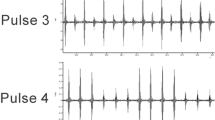Abstract
InDrosophila montana andD. littoralis (species of theD. virilis group), females use male courtship song in their mate choice in wild preferring males which produce short and dense sound pulses (Aspi and Hoikkala, 1995). In the present study these song characters were found to be repeatable among overwintered males. Male progenies of wild-caught flies reared in the laboratory, and inD. montana also the males collected in wild before overwintering, exhibited very little variation between males in these characters. Contrary to pulse characters, pulse train characters measured forD. montana song varied significantly between laboratory-reared males. Our findings suggest that inD. montana andD. littoralis song characters playing a part in sexual selection in the wild are more condition dependent than song characters which are not the direct targets of female choice.
Similar content being viewed by others
References
Andersson, M. (1986). Evolution of condition-dependent sex ornaments and mating preferences: Sexual selection based on viability differences.Evolution 40: 804–820.
Aspi, J., and Hoikkala, A. (1993). Laboratory and natural heritabilities of male courtship song characters inDrosophila montana andD. littoralis.Heredity 70: 400–406.
Aspi, J., and Hoikkala, A. (1995). Male mating success and survival in the field with respect to size and courtship song characters inDrosophila littoralis andD. montana (Diptera: Drosophilidae).J. Insect Behav. 8: 67–87.
Becker, W. A. (1984).A Manual of Quantitative Genetics, Academic Enterprises, Pullman, WA.
Boake, R. B. (1989). Repeatability: Its role in evolutionary studies of mating behavior.Evolut. Ecol. 3: 173–182.
Butlin, R., and Hewitt, G. M. (1986). Heritability estimates for characters under sexual selection in grasshopper,Chorthippus brunneus.Anim. Behav. 34: 1256–1261.
Clark, D. C., and Moore, A. (1995). Variation and repeatability of male agonistic his characters and their relationship to social rank inGromphadorhina portentosa.Anim. Behav. 50: 719–729.
Falconer, D. S. (1981).Introduction to Quantitative Genetics, 2nd ed., Longman, New York.
Fisher, R. A. (1958).The Genetical Theory of Natural Selection, 2nd ed., Dover, New York.
Gerhardt, H. C. (1991). Female mate choice in treefrogs: Static and dynamic acoustic criteria.Anim. Behav. 42: 615–635.
Iwasa, Y., Pomiankovski, A., and See, N. (1991). The evolution of costly mate preference. II. The “handicap principle.”Evolution 45: 1431–1442.
James, A. C., and Jaenike, J. (1992). Determinants of mating success in wildDrosophila testacea.Anim. Behav. 44: 168–170.
Lessells, C. M., and Boag, P. T. (1987). Unrepeatable repeatables: A common mistake.Auk 104: 116–121.
Lumme, J. (1978). Phenology and photoperiodic diapause in northern populations ofDrosophila. In Dingle, H. (ed.),Evolution of Insect Migration and Diapause, Springer-Verlag, New York, pp. 145–170.
Markow, T. A., and Ricker, J. P. (1992). Male size, developmental stability, and mating success in natural populations of threeDrosophila species.Heredity 69: 122–127.
Partridge, L., Hoffman, A. A., and Jones, J. S. (1987). Male size and mating success inDrosophila melanogaster andDrosophila pseudoobscura under field conditions.Anim. Behav. 35: 468–476.
Pomiankovski, A., Iwasa, Y., and See, N. (1991). The evolution of costly mate preference. I. Fisher and biased mutation.Evolution 45: 1422–1430.
Scherrer, J. A., and Wilkinson, G. S. (1993). Evening bat isolation calls provide evidence for heritable signatures.Anim. Behav. 46: 847–860.
Taylor, C. E., and Kekic, V. (1988). Sexual selection in natural populations ofDrosophila melanogaster.Evolution 42: 197–199.
Zahavi, A. (1977). The cost of honesty: Further remarks on the handicap principle.J. Theor. Biol. 67: 603–605.
Author information
Authors and Affiliations
Rights and permissions
About this article
Cite this article
Hoikkala, A., Isoherranen, E. Variation and repeatability of courtship song characters among wild-caught and laboratory-rearedDrosophila montana andD. littoralis males (Diptera: Drosophilidae). J Insect Behav 10, 193–202 (1997). https://doi.org/10.1007/BF02765552
Received:
Revised:
Issue Date:
DOI: https://doi.org/10.1007/BF02765552




